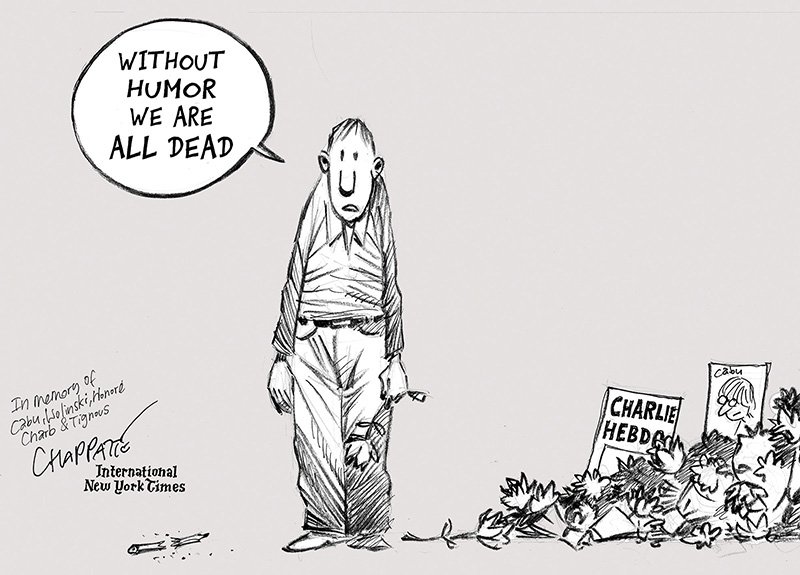New York Times Editorial Cartoons Gone
America's Newspaper of Record has decided the backlash isn't worth it.

Patrick Chappatte laments the loss of his job . . . and something more profound.
All my professional life, I have been driven by the conviction that the unique freedom of political cartooning entails a great sense of responsibility.
— “The end of political cartoons at The New York Times”
In 20-plus years of delivering a twice-weekly cartoon for the International Herald Tribune first, and then The New York Times, and after receiving three OPC awards in that category, I thought the case for political cartoons had been made (in a newspaper that was notoriously reluctant to the form in past history.) But something happened. In April 2019, a Netanyahu caricature from syndication reprinted in the international editions triggered widespread outrage, a Times apology and the termination of syndicated cartoons. Last week, my employers told me they’ll be ending in-house political cartoons as well by July. I’m putting down my pen, with a sigh: that’s a lot of years of work undone by a single cartoon – not even mine – that should never have run in the best newspaper of the world.
I’m afraid this is not just about cartoons, but about journalism and opinion in general. We are in a world where moralistic mobs gather on social media and rise like a storm, falling upon newsrooms in an overwhelming blow. This requires immediate counter-measures by publishers, leaving no room for ponderation or meaningful discussions. Twitter is a place for furor, not debate. The most outraged voices tend to define the conversation, and the angry crowd follows in.
Chapatte has literally been there from the beginning:
In 1995, at twenty-something, I moved to New York with a crazy dream: I would convince the New York Times to have political cartoons. An art director told me: “We never had political cartoons and we will never have any.” But I was stubborn. For years, I did illustrations for NYT Opinion and the Book Review, then I persuaded the Paris-based International Herald Tribune (a NYT-Washington Post joint venture) to hire an in-house editorial cartoonist. By 2013, when the NYT had fully incorporated the IHT, there I was: featured on the NYT website, on its social media and in its international print editions. In 2018, we started translating my cartoons on the NYT Chinese and Spanish websites. The U.S. paper edition remained the last frontier. Gone out the door, I had come back through the window. And proven that art director wrong: The New York Times did have in-house political cartoons. For a while in history, they dared.
Along with The Economist, featuring the excellent Kal, The New York Times was one of the last venues for international political cartooning – for a U.S. newspaper aiming to have a meaningful impact worldwide, it made sense. Cartoons can jump over borders. Who will show the emperor Erdogan that he has no clothes, when Turkish cartoonists can’t do it ? – one of them, our friend Musa Kart, is now in jail. Cartoonists from Venezuela, Nicaragua and Russia were forced into exile. Over the last years, some of the very best cartoonists in the U.S., like Nick Anderson and Rob Rogers, lost their positions because their publishers found their work too critical of Trump. Maybe we should start worrying. And pushing back. Political cartoons were born with democracy. And they are challenged when freedom is.
While I have few regrets, indeed, over my long-ago transition from reading a single daily newspaper in hard copy to reading dozens of articles online from a variety of sources, I have some. Most importantly, while I’ve deliberately made myself read from a pretty wide ideological and geographic spectrum, the sheer volume of news available online has led to my reading less widely in terms of content. But Chappatte reminds me that I’ve largely stopped reading political cartoons, which were once upon a time a highlight of my day and often wound up clipped and taped to my office door or shared with students via overhead projector slides.
He’s right that political cartoons can be quite powerful, often moreso than the printed word. And he’s right, too, about the nature of the online outrage machine.
I don’t blame the New York Times for this decision. They’re first and foremost in the news reporting business. To the extent defending controversial cartoons is a distraction from that, it’s probably not worth it to them.
A few years back, I noted a controversy over an “Obama’s America” cartoon which leveraged a then-popular Internet meme and the fresh pain of the University of Alabama’s loss to hated rival Auburn on a freak football play. In a post-irony era, the cartoon was deemed racist and the paper had to issue an apology. It was perhaps inevitable that the medium would go downhill after that.
Chappatte is more optimistic:Curiously, I remain positive. This is the era of images. In a world of short attention span, their power has never been so big. Out there is a whole world of possibilities, not only in editorial cartooning, still or animated, but also in new fields like on-stage illustrated presentations and long-form comics reportage – of which I have been a proponent for the last 25 years. (I’m happy, by the way, to have opened the door for the genre at the NYT with the “Inside Death Row” series in 2016. The following year, another series about Syrian refugees by Jake Halpern and Michael Sloan got the NYT a Pulitzer prize.) It’s also a time where the media need to renew themselves and reach out to new audiences. And stop being afraid of the angry mob. In the insane world we live in, the art of the visual commentary is needed more than ever. And so is humor.
Yes, but it may not be possible.
We’ve long known that effective satire is virtually impossible. Those who already agree with the satirist find it hysterically funny but those who disagree either aren’t in the audience or take the jokes seriously. The people Norman Lear were trying to persuade with “All in the Family” found Archie Bunker to be an endearing character who was making good sense.
The problem is made worse by our polarized era. Even though I’m on the same side as the “Saturday Night Live” crew vis-a-vis President Trump, I don’t really find the constant stream of invective posing as humor funny. I’ve largely tuned out John Oliver and Stephen Colbert, too. At some point, it’s just piling on.




It’s been so long since I’ve picked up a paper newspaper that I honestly forgot that the Times even had editorial cartoons. If they were available online, I must have missed them.
I hear you. It’s hard to watch things you’ve known all your life die.
At the same time, I have a number of cartoons in my RSS feed. They maybe aren’t Oliphant or Chapatte, or even editorial cartoons, but they are funny and relevant. Maybe some other readers can mention their favorites? Mine would be XKCD (xkcd.com), but it’s pretty tech-oriented.
@Doug Mataconis: I believe they were primarily, if not exclusiovely, in the international edition.
From the Ha’Aretz story on the decision
Basically, I think it is pretty pathetic that they are doing this. It amounts to deciding that they can’t trust themselves to not be bigoted and that it is easier to not have cartoons than to use proper judgement.
@SKI:
Ah that explains it.
Timeless…
No, it’s the opposite of “piling on”. Piling on is what the strong do to the weak. Satire is what the weak do to the strong. Restricting satire is an earmark of totalitarianism.
@DrDaveT: Oh, I have zero sympathy for Trump. But humor only works if it draws laughter from those who disagree. I started watching Colbert and The Daily Show during the Bush administration. Despite liking Bush and having voted for him twice, I found the satire humorous and mostly fair. With Trump, it just seems mean. Not unjustified, mind you. Just mean. And therefore not funny.
I’m not sure they can do any part of their job unless they’re willing to make judgements and stand by them. This attitude may explain some of their failings over the last few years.
@James Joyner:
I have to admit that this baffles me. Can you give some examples of satire aimed at Trump that you think is both funny and not ‘mean’? To me, ‘mean’ implies unfair, so I honestly don’t understand how a depiction can be both justified and mean. I can understand it being justified and unfunny, but not ‘mean’.
What exactly is “effective” in terms of satire? I don’t believe the intent of satire has ever been to influence or change minds. Satire, from Aristophanes, meant to expose hard truths and ridicule the powerful.
Mocking Trump is made difficult because he makes a mockery of himself. Caricature is supposed to be an exaggeration of the subject, but when Trump behaves like a cartoon every day, how can a caricature not have to approach absurdity?
@Scott F.:
I believe this a key point, and it’s hard not to understate. Trump is such a total and absolute cartoon of a human being that words fail just attempting to describe him straight. If you visited an alternate universe in which he never existed you’d have a tough time convincing anyone that a man like him ever could exist. They’d think you were coming up with an absurd parody. No matter how much you insisted he was a walking cartoon, they’d wind up thinking you must be exaggerating, at least a little. But you wouldn’t be–not by an iota. Trump seems to be a literal walking embodiment of a satiric skit of a crooked, narcissistic politician or celebrity. There’s nothing to satirize, since the real man is maximally ridiculous. How do you satirize the moment when he reacted to the Access Hollywood tape by saying “No one respects women more than I do”? SNL didn’t bother. They just had Baldwin speak the line verbatim before cutting to shots of the entire planet laughing. Trump has effectively killed satire by showing that it’s possible for someone to be every bit as ridiculous as a satiric character and still be taken seriously by a sizable portion of the populace.
Trump is a man with no sense of humor. Or rather, he thinks ridiculing people shows a sense of humor. If he were able to use humor effectively (it worked for JFK and Reagan), he wouldn’t come across as nothing more than a garden-variety boor and moron.
As Tom Lehrer said,
It’s probably mostly true that political cartoons won’t change minds, but that’s also true of the rest of the paper. Unless, of course, they do wall to wall reporting on HER EMAILS!!! and the squeaky clean Clinton Foundation while ignoring Trump’s little peccadilloes, like money laundering, a corrupt foundation, a corrupt “university”, a corrupt vodka company, corrupt casinos, bimbos, lying about Trump Tower Moscow, and so on and so on. In any case, politics, like economics, works at the margin. To be effective it only needs to change a few minds.
@SC_Birdflyte: To be fair, punching down IS conservative humor.
@Scott F.:
That’s an interesting comment. My first reaction was to immediately contradict you, to say that influencing and changing minds is the entire purpose of satire. That’s probably not exactly right, though.
Historically, the purpose of satire has been to shine a light on aspects of society that people would prefer not to notice; to make people uncomfortable with the status quo; to take seemingly reasonable arguments to their unreasonable (but logical) conclusions. When Jonathan Swift wrote “A Modest Proposal”, the intent was to make people feel viscerally the inadequacy and basic inhumanity of Britain’s treatment of Ireland. I think that certainly counts as intending to ‘influence’. Gulliver’s Travels had much less focused goals; it was trying to get people to see the worst aspects of English (and human) society through fresh eyes. Again, not really trying to change anyone’s mind on a particular issue, but certainly intending to influence thought and discourse.
I think of satire as the tool by which social commenters can safely “punch up” at the powerful. The powerful cannot admit to being the target of the satire without acknowledging its accuracy (though of course Trump hasn’t figured that out yet). So yes, to some extent the point of the satire is to get in a jab at those who deserve to be jabbed, but it is also aimed at raising general social awareness of what needs to be changed.
@Kylopod:
There is lots to satirize. There is a French TV show that has Trump dining with the Ku Klux Klan or singing “Can’t Stop the Fascism” with Marine Le Pen .
These type of satire can be pretty effective on dealing with what’s in practice is a White Supremacist and with countries importing these type of rhetoric. And if people are uncomfortable with how Colbert and The Daily Show are dealing with Trump that’s good. Satire is supposed to be mean and uncomfortable.